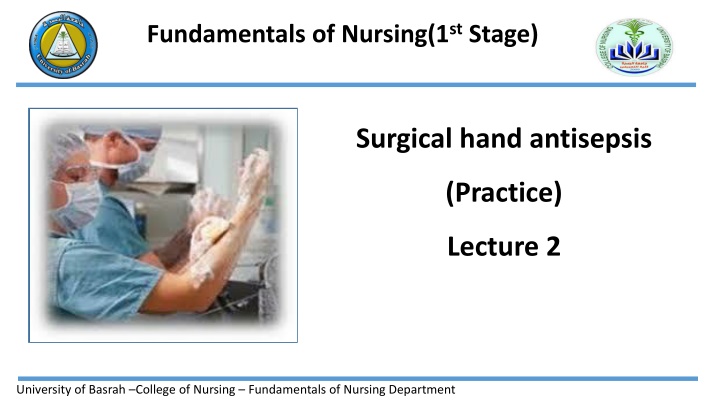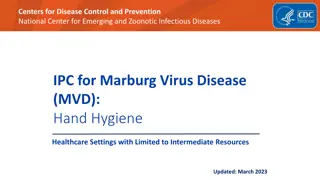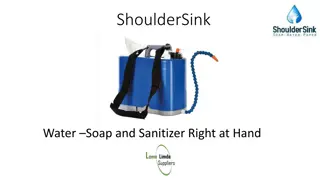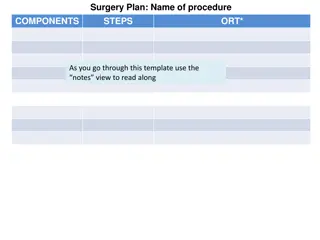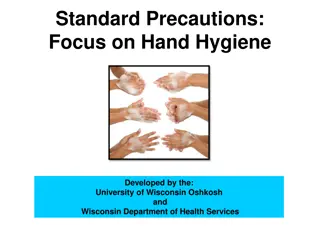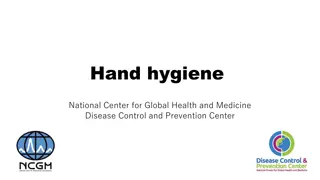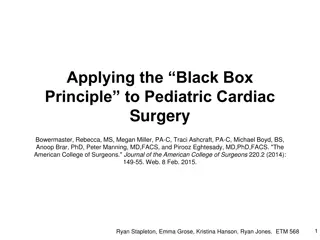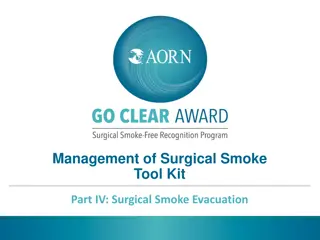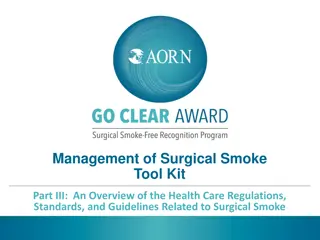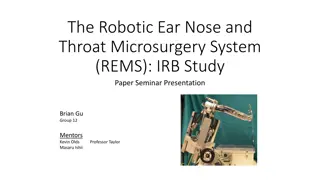Surgical Hand Antisepsis in the Operating Room Setting
Achieving effective surgical hand antisepsis is crucial in the operating room to reduce the risk of surgical site infections. This involves using antimicrobial agents and sterile brushes to remove debris and microorganisms, reduce microbial counts, and prevent rapid growth. The process requires equipment like a deep sink, antimicrobial agent, surgical scrub brush, and sterile towel. Proper assessment of hand hygiene and nursing diagnosis of infection and injury risks are essential steps in maintaining patient safety during surgical procedures.
Download Presentation

Please find below an Image/Link to download the presentation.
The content on the website is provided AS IS for your information and personal use only. It may not be sold, licensed, or shared on other websites without obtaining consent from the author.If you encounter any issues during the download, it is possible that the publisher has removed the file from their server.
You are allowed to download the files provided on this website for personal or commercial use, subject to the condition that they are used lawfully. All files are the property of their respective owners.
The content on the website is provided AS IS for your information and personal use only. It may not be sold, licensed, or shared on other websites without obtaining consent from the author.
E N D
Presentation Transcript
Fundamentals of Nursing(1st Stage) Surgical hand antisepsis (Practice) Lecture 2 University of Basrah College of Nursing Fundamentals of Nursing Department
Introduction In the operating room setting it is imperative that surgical hand antisepsis be achieved through effective surgical scrub to reduce the risk of acquired postoperative infection.
The inadvertent transfer of microorganisms such as bacteria to a patient's wound site during surgery can result in a wound infection that is commonly called a surgical site infection (SSI).
Surgical site infection (SSI): are one of the most common forms of health care- associated infections for surgical patients.
Purpose Through the use of antimicrobial agent and sterile brushes, the surgical hand scrub can: 1.Removes debris and transient microorganisms from the nails, hands, and forearms. 2.Reduce the resident microbial count to a minimum. 3.Inhibits rapid/ rebound growth of microorganisms.
Equipment 1. Deep sink with foot or knee controls. 2. Antimicrobial agent 3. Surgical scrub brush with plastic nail file. 4. Sterile towel
Surgical scrub brush with plastic nail file Deep sink Sterile towel Antimicrobial agent
Assessment 1. Remove bracelets, rings, and watches. 2. Inspect fingernails, which must be short, clean. 3. Artificial nails should not be worn. 4. Inspect condition of cuticles, hands, and forearms for presence of abrasions, cuts or open lesions.
Nursing diagnosis 1. Risk for infection 2. Risk for injury
Planning Client will not develop signs of surgical wound infection
Implementation 1- Turn water on using foot or knee control, and adjust to comfortable temperature. 2- Pre-scrub wash/rinse: A. Wet hands and forearms under running, lukewarm water. B. Lather with antimicrobial agent up to 20 inches above elbows. C. Keep hands elevated above elbows. D. Rinse hands and arms thoroughly under running water. 3- Under running water, clean under nails of both hands with plastic nail file and discard it.
4- Scrubbing with brush: A.Wet brush and apply antimicrobial agent. B.Visualize each finger, hand, and arm as having 4 sides. C. Scrub the nails of one hand with 15 strokes.
D. Scrub each side of palm, each side of thumb, each side of fingers, and posterior side of hand with 10 stroke each. E. Divide the arm mentally into three part, scrub(4 sides) for each part 10 stroke. F. Rinse brush and repeat the steps for the other arm.
5- Discard brush, flex arms, and rinse from fingertips to elbows in one continuous motion. 6- Turn off water with foot or knee control, with hand elevated in front of and away from body. 7- Enter operating room. 8- Grasp one end of the sterile towel to dry one hand thoroughly, moving from fingers to elbow in a rotating motion. 9- Discard towel.
Evaluation Observe the client for signs of localized wound infection( usually occurs 2-3 days postoperatively) which includes: 1. Redness 2. Swelling 3. Hotness 4. Pain 5. Pus
